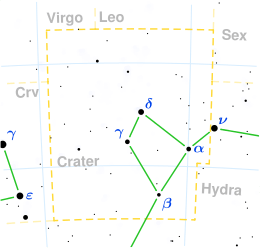Epsilon Crateris
Epsilon Crateris (ε Crateris) is a solitary[12] star in the southern constellation of Crater. Visible to the naked eye, it has an apparent visual magnitude of 4.84.[2] It is located in the sky above Beta Crateris, and slightly to the left, or east, marking the lower right edge of the rim of the bowl and is somewhat closer to Theta Crateris, which is further east at the top of the bowl. With an annual parallax shift of 8.67[1] mas as seen from the Earth, its estimated distance is around 376 light years from the Sun.
 | |
| Observation data Epoch J2000.0 Equinox J2000.0 (ICRS) | |
|---|---|
| Constellation | Crater |
| Right ascension | 11h 24m 36.59019s[1] |
| Declination | −10° 51′ 33.5591″[1] |
| Apparent magnitude (V) | 4.84[2] |
| Characteristics | |
| Spectral type | K5 III[3] |
| U−B color index | +1.87[2] |
| B−V color index | +1.55[2] |
| Astrometry | |
| Radial velocity (Rv) | +2.0±0.6[4] km/s |
| Proper motion (μ) | RA: −25.65[1] mas/yr Dec.: +24.96[1] mas/yr |
| Parallax (π) | 8.9013 ± 0.2019[5] mas |
| Distance | 366 ± 8 ly (112 ± 3 pc) |
| Absolute magnitude (MV) | −0.43±0.18[6] |
| Details | |
| Mass | 0.99±0.08[6] M☉ |
| Radius | 44.7[7] R☉ |
| Luminosity | 391[8] L☉ |
| Surface gravity (log g) | 1.61[9] cgs |
| Temperature | 3,930[9] K |
| Metallicity [Fe/H] | −0.38[9] dex |
| Rotational velocity (v sin i) | 10[10] km/s |
| Other designations | |
| Database references | |
| SIMBAD | data |

This is an evolved K-type giant star with a stellar classification of K5 III.[3] It has about the same mass as the Sun, but has expanded to 44.7[7] times the Sun's radius. The star is radiating 391[8] times the solar luminosity from its outer atmosphere at an effective temperature of 3,930 K.[9]
References
- van Leeuwen, F. (2007), "Validation of the new Hipparcos reduction", Astronomy and Astrophysics, 474 (2): 653–664, arXiv:0708.1752, Bibcode:2007A&A...474..653V, doi:10.1051/0004-6361:20078357.
- Mermilliod, J.-C. (1986), "Compilation of Eggen's UBV data, transformed to UBV (unpublished)", Catalogue of Eggen's UBV Data, SIMBAD, Bibcode:1986EgUBV........0M.
- Houk, N.; Swift, C. (1999), "Michigan catalogue of two-dimensional spectral types for the HD Stars", Michigan Spectral Survey, Ann Arbor, Michigan: Department of Astronomy, University of Michigan, 5, Bibcode:1999MSS...C05....0H.
- de Bruijne, J. H. J.; Eilers, A.-C. (October 2012), "Radial velocities for the HIPPARCOS-Gaia Hundred-Thousand-Proper-Motion project", Astronomy & Astrophysics, 546: 14, arXiv:1208.3048, Bibcode:2012A&A...546A..61D, doi:10.1051/0004-6361/201219219, A61.
- Brown, A. G. A.; et al. (Gaia collaboration) (August 2018). "Gaia Data Release 2: Summary of the contents and survey properties". Astronomy & Astrophysics. 616. A1. arXiv:1804.09365. Bibcode:2018A&A...616A...1G. doi:10.1051/0004-6361/201833051. Gaia DR2 record for this source at VizieR.
- da Silva, L.; et al. (November 2006), "Basic physical parameters of a selected sample of evolved stars", Astronomy and Astrophysics, 458 (2): 609–623, arXiv:astro-ph/0608160, Bibcode:2006A&A...458..609D, doi:10.1051/0004-6361:20065105.
- Setiawan, J.; et al. (July 2004), "Precise radial velocity measurements of G and K giants. Multiple systems and variability trend along the Red Giant Branch", Astronomy and Astrophysics, 421: 241–254, Bibcode:2004A&A...421..241S, doi:10.1051/0004-6361:20041042-1.
- McDonald, I.; et al. (2012), "Fundamental Parameters and Infrared Excesses of Hipparcos Stars", Monthly Notices of the Royal Astronomical Society, 427 (1): 343–57, arXiv:1208.2037, Bibcode:2012MNRAS.427..343M, doi:10.1111/j.1365-2966.2012.21873.x.
- McWilliam, Andrew (December 1990), "High-resolution spectroscopic survey of 671 GK giants", Astrophysical Journal Supplement Series, 74: 1075–1128, Bibcode:1990ApJS...74.1075M, doi:10.1086/191527.
- Bernacca, P. L.; Perinotto, M. (1970), "A catalogue of stellar rotational velocities", Contributi Osservatorio Astronomico di Padova in Asiago, 239 (1), Bibcode:1970CoAsi.239....1B.
- "* eps Crt -- Star". SIMBAD. Centre de données astronomiques de Strasbourg. Retrieved 2017-03-01.
- Eggleton, P. P.; Tokovinin, A. A. (September 2008), "A catalogue of multiplicity among bright stellar systems", Monthly Notices of the Royal Astronomical Society, 389 (2): 869–879, arXiv:0806.2878, Bibcode:2008MNRAS.389..869E, doi:10.1111/j.1365-2966.2008.13596.x.